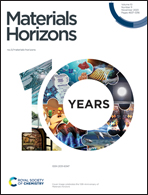Negative differential resistance based on phase transformation†
Abstract
The negative differential resistance (NDR) device is attracting attention because of its broad potential application in neuromorphic computing and non-volatile memory. However, only a limited range of materials show NDR and, therefore, there is less choice in material selection for NDR devices. Considering this issue, we here demonstrate a novel current controlled NDR device based on phase transformation. To the best of our knowledge, this report is the first experimental demonstration that NDR can be induced by phase transformation. We believe that the impact of this demonstration is very large, as phase transformation is the most common phenomenon in materials and consequently most materials can be reconsidered as possible candidates for NDR devices. The prototype NDR device is constructed using hydrogen absorbing metal palladium (Pd) thin-wire and the phase transformation from metal-hydride to metal is employed for the demonstration. The observed NDR property shows a strong dependence on the current sweep speed. Also, it exhibits no current polarity dependence. Therefore, the NDR device based on phase transformation is significantly different from typical NDR devices such as tunnel diodes and memristors. The prototype NDR device has been found to be very useful for evaluating the hydrogen storage properties of metals. The advantage of this analysis method is that the storage properties can be acquired just by sweeping the applied current. This demonstration offers novel directions for both the development and utilization of NDR devices.



 Please wait while we load your content...
Please wait while we load your content...